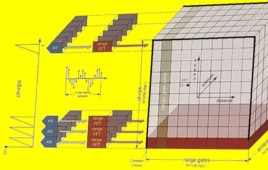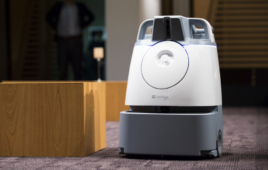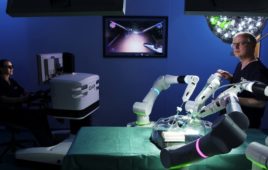
The drone inspection if Salesforce Tower shows how software can save time, risk, and money. Source: SiteAware
An unmanned aerial vehicle recently flew around Salesforce Tower, the tallest building in San Francisco. Drone inspections are a growing alternative to other methods of inspection, but they need sophisticated software to make sense of the data gathered. Building owner Boston Properties Inc. turned to SiteAware Systems Ltd. for the drone inspection of Salesforce Tower.
Zeev Braude, CEO of SiteAware in Tel Aviv, Israel, spoke with The Robot Report about the development of software and services for drone inspections.
“We are transforming quality control in construction from human physical work on the job site to a cloud-based, digital online operation,” he said. “The challenge with doing physical work on a construction site is very different from industrial quality control on a production line. Conditions are more variable outdoors.”
“We’re able to leverage computer vision and artificial intelligence to provide real-time service, to allow people actually doing the job to do preventive work rather than repair work, which is very costly,” Braude said.
The inspection of Salesforce Tower (formerly known as the Transbay Tower) took days rather than the months it would have taken to do so with people on swing stage platforms, reported the San Francisco Chronicle. Drone inspections cost only tens of thousands of dollars and don’t endanger workers.
Building software for drone inspections
“When you think of the challenge of façade inspection, there are three portions to consider: data capture, mapping elevation, and classifying data,” Braude explained. “We did the drone inspection of Salesforce Tower with a Phantom Pro 4, which is a fairly basic drone.”
Data capture includes ease-of-use and safety measures for drone inspections. “In a site that’s fairly large, you can have 100% autonomous flight, but in a construction job site, GPS may not necessarily work,” said Braude.
A drone inspection of San Francisco’s Millennium Tower went awry in September, with the vehicle crashing to the ground from the 36th floor. Nobody was injured.
“We developed our own software that uses the DJI APIs and joystick control,” Braude said. “This allows us to develop mission-control software on top of that to accurately identify obstacles such as a crane.”
“We can also better control the overlapping of images, and we can decide how close to fly to an object,” he noted. “Our system is fully autonomous, but the role of the pilot is for safety.”
“With our drone, if the battery goes to a certain percentage, it can go down and resume the mission from where it left off,” Braude said of SiteAware’s systems. “Our monitoring tools give the ability to make sure we can get around GPS issues.”
“The second part is that you need to map the elevation of the building,” he said. “For a building like Salesforce Tower, you’re taking like 8,000 photos. You can’t just use a video of the building or just still photos — you need to know the 47th floor from the 39th floor.”
SiteAware currently relies on cameras and thermal sensors for its drone inspections, Braude said.
“We do plan to expand views of building interiors, but our capabilities are more around quality-control tools,” he said. “A number of companies are looking to provide technology to capture point clouds using cameras and lidar, and we want to work with them. We’ll take the data to provide something meaningful for construction.”
“The third layer is to do the inspection itself — classifying data with AI systems,” said Braude. “For example, we know how to identify trouble spots in a façade, and we’re training our machine-learning systems on classifying errors.”

Photo taken during a DJI drone inspection with SiteAware software and DroneHive operators. Source: SiteAware
Providing on-site feedback
Drone inspections provided by companies such as SiteAware enable builders to make adjustments more quickly and real estate developers and insurers to inspect existing structures.
“The assumption that production architects are delivering in terms of the plan is that this is doable,” Braude said. “Our objective is really to improve the quality of the work.”
“We’re providing a measuring tool with an accuracy of less than half an inch. When we provide a report on [a building’s] decks, we have an accuracy today of a quarter to an eighth of an inch,” he added. “That enables people on the site to do better work. Correcting a nonconformance on the job site can slow construction.”
“We’re also looking at workmanship and warranties,” explained Braude. “Many façade issues are related to following instructions during installation. It’s important that we come not only for the finished goods, but also during the process for integrity.”
“For example, we sometimes see a façade with screws that need sealant around them, according to the warranty. That’s not really an engineering job, but it’s part of quality control,” he said. “Now that somebody’s controlling that, it changes perceptions and will be more accurate.”
 Keynotes | Speakers | Exhibitors | Register
Keynotes | Speakers | Exhibitors | Register
SiteAware integration partners
SiteAware’s cloud-based system works with products from Autodesk, PlanGrid, and Procore, and the company is open to other partners.
“One of the main reasons to build those integration partners is seamless data sharing,” Braude said. “Their premise is a paperless revolution, and we’re able to capture the data and send it back through one of those integrations to the project team.”
“If we scan a deck in the morning, we need to be able to provide data to people in the field in a few hours,” he said. “Most are using one of those tools.”
Drones as a service
SiteAware, which has about 15 employees, provides its services in a software-as-a-service model. For the Salesforce Tower job, it worked with DroneHive Inc., a Corte Madera, Calif.-based staffing provider for drone inspections.
“We’re a data company at the end of the day,” Braude said. “We don’t provide operators for our customers, so we chose DroneHive because we wanted its support for the sales and project side. It’s a really nice collaboration.”
“DroneHive sent two people — a pilot and a spotter — to the job site to monitor activities,” he said. “We worked with them on training on our software and preflight. They eventually went and did full inspection.”

Cloud-based AI accounts for a lack of GPS and handles data gathering and analysis. Source: SiteAware
SiteAware and DroneHive’s services are currently available to real estate developers and contractors, and operators of drone inspections can also contact them directly.
“Today, we’re mainly targeting two parts of the U.S. drone inspections market: the construction itself, and providing building monitoring as a service,” said Braude. “In addition, we’re coming to different stages during building. For example, in the case of the Salesforce Tower, we came right after construction.”
“Inspection services for existing buildings are very difficult with traditional tools,” he said. “Using a combination of autonomous drones and our software is very comprehensive and can reduce friction and cost.”
“For example, we recently served a drone inspection of a partial façade of a retail center,” Braude said. “It took about two hours, and we sent management the report within 24 hours.”
Filed Under: AI • machine learning, The Robot Report





Tell Us What You Think!